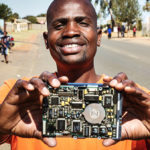Water is everywhere. It covers 70% of our planet and makes up nearly 60% of the human body. Despite its abundance, 663 million people around the world lack access to safe water.
Another 2.4 billion people lack access to a toilet or latrine, while more than 3.5 million people die each year because of inadequate water supply, sanitation, or hygiene. The earth may be covered in water, but only 3% of that is fresh water, and only a small fraction of that is available to the planet’s 7.5 billion inhabitants.
In many communities in developing countries, the lack of access is compounded by a number of challenges, including poor sanitation, lack of awareness of hygiene practices and water treatment technologies, and limited local capacity to manage, maintain, and repair water points.
Lack of access to clean water and sanitation results in economic losses of $260 billion each year and poor communities are impacted most acutely. The burden of water collection falls primarily on women and children, who spend 125 million hours each day collecting water, often walking long distances to do so. This is time and energy that could be better spent in school, pursuing careers, or supporting their families.
The impact of a dollar and a drop
Water is tied to every aspect of our lives. Clean water and sanitation is a critical part of the United Nations’ Sustainable Development agenda, and it’s uniquely tied to all 17 of its overarching goals. It drives economic growth, supports food and energy production, and is key to biodiversity, health, and social development.
It’s no wonder that for every US$1 invested in water, sanitation, and hygiene (WASH), we see a US$4.30 return. Access to safe water means fewer illnesses, reduced health care costs, improved school attendance, and longer, more productive lives.
Tapping into the power of digital solutions
At Cisco, we recognize the need for sustainable access to safe water and the tremendous impact of ensuring access to clean water on all aspects of society. It’s why we’ve awarded over 21 grants to nine different nonprofit grantees since 2010, reaching more than 3900 organizations and nearly 50 million people.
By investing in digital solutions, we are helping nonprofit organizations to increase the efficiency and quality of their programs, reduce overall costs, and enable greater reach and scale of WASH initiatives around the world.
Akvo Foundation, for example, creates open-source, mobile software and sensors to help partners improve the management of water and sanitation. Today, their mobile-based data collection tool, Akvo FLOW, is used by over 250 organizations in over 40 countries, enhancing the ability of governments, nonprofits, and communities to plan, implement, and remotely manage WASH projects. Their new tool, Akvo Lumen, helps organizations aggregate, map, and analyze their data for greater insights and actionable information.
Portland State University and Sweet Sense, its social enterprise spin-off, have developed low-cost, remote sensors to improve the reliability and sustainability of water service delivery. Their sensors can alert local maintenance workers via SMS when a water point breaks down, reducing response time and downtime of water points, thus improving access and the reliability of water sources.
Technology can also help bridge the vast human resource capacity gap in the WASH sector. A recent study in just 10 countries found that in order to reach Sustainable Development Goal 6 of access to safe water and sanitation for all, more than 787,000 trained WASH professionals are needed.
The Centre for Affordable Water and Sanitation Technology (CAWST) provides online resources and virtual training to local organizations, to build their capacity in meeting their communities’ needs for water, sanitation, and hygiene. CAWST’s Virtual Water Expertise and Training (WET) Centres use internet-based solutions — such as e-training modules, online information resources, webinars and video-based training — to expand the reach of CAWST’s services to more than 3000 organizations in 164 countries.
We know the Sustainable Development Goals are bold, ambitious targets. We also know that technology can play a critical role in achieving these goals.
Organizations such as Akvo Foundation, Sweet Sense, and CAWST demonstrate the impact that technology can have in addressing water and sanitation challenges, and in helping realize SDG 6: to ensure availability and sustainable management of water and sanitation for all.
Access to clean and safe water is a human right, one we believe in and continue to support. On World Water Day, we recognize the governments, fellow companies, nonprofit organizations, and communities around the world working to achieve universal coverage for all.
Visit csr.cisco.com to learn more about Cisco’s support for nonprofits and technology-based solutions.


Hi Erin Conner,
I am a 34 year old student at the Colorado Christian University. I am studying Business Ethics currently and I found your article, which I have to say is very insightful and enlightening. I had no idea how many people are truly without safe water, bathrooms, and more. I have to applaud all of the nonprofits who have received grants from CISCO so far. It would be nice if more nonprofits or just everyday companies, would try to help like you all have done. As I have learned, It is a companies responsibility to help with the community and to show they care.